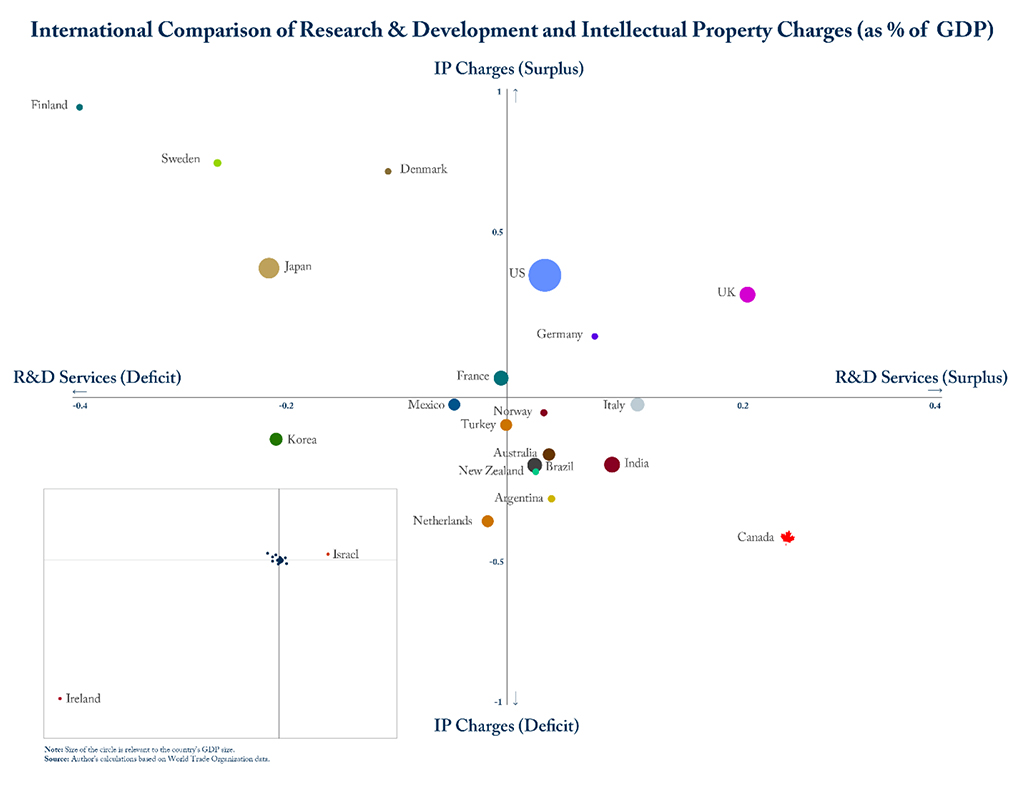To: Ontario ministers in charge of innovation policy
From: Daniel Schwanen
Date: December 17, 2021
Re: Canada’s Commercialization Deficit
There is an extensive, almost century-old, body of literature on Canada’s struggles with innovation and related systems. The constant thread is that there is no lack of good Canadian ideas, research, or access to intellectual property (IP). The failure, instead, stems from a lack of success in turning these ideas and IP, and the skills of Canadians, into commercial successes (see Council of Canadian Academies 2013, Nicholson 2016).
Part of this commercialization deficit is connected to Canada’s difficulty growing smaller businesses into larger ones. In turn, the relative dearth of vibrant mid-sized businesses has long been linked to lagging Canadian productivity and hence lagging average standards of living relative to comparators such as the United States (Baldwin et al. 2014).
To be sure, there are many sub-facets of this problem.
Under-investment by Canadian firms and governments, relatively low levels of angel and seed capital financing, the size of Canada’s own market, protectionism and over-regulation in many sectors combine to stifle innovation. One can add our habit of policies that tend to favour businesses that stay small. And, as well, weak protection for Canadian IP in some large external markets may contribute to the problem.
The overall pattern is that Canada is a research- and ideas-producing economy, that sees relatively few of the ideas generated here (or poaching those generated elsewhere) commercialized by Canadian firms. This deficit, in turn, detracts from Canada's ability to generate incomes as high as they could be based on its comparative advantages, such as its highly educated population.
This question is particularly salient for Ontario, which is home to 45 percent of Canada’s research and development spending and home base to 43 percent of Canadian patents.
One way to illustrate Canada’s situation in this respect is with the chart below of countries’ trade surpluses or deficits in research and development services, plotted against their trade surplus/deficit in payments for the use of IP (e.g. copyrights or royalties). In the chart, both these balances are expressed as a share of GDP.

Canada stands out as a net exporter of research services, while at the same time being a net importer of IP services, that is, it pays significant sums to non-Canadian holders of IP.
For example, employees of Google in Kitchener (or Ubisoft, and many others) produce research that is an export of service for Canada to the parent company outside the country. These exports generate high value added jobs and incomes and contribute to building research talent in Canada.
Yet, such activities generate IP which does not rest with a Canadian company: Contrast with the US, UK and Germany, or Israel, countries that not only produce research but also collect, on the net, ongoing fees from other countries for the use of IP owned by their residents.
Or contrast with Nordic countries – think of companies like Nokia from Finland, Ikea from Sweden, Lego from Denmark – whose research is often performed by international partners, and so import research services, but own the IP embedded in the products they sell or license. The latter then counts as income in their home countries’ balance of payments.
In short, Canada has an almost unique IP commercialization problem, but not an IP generation problem.
How do we fix this?
Closing this commercialization gap requires making Ontario more attractive as a place to take entrepreneurial risks and grow a business, to connect the ideas with potential commercial opportunities. This means better leveraging our public institutions, notably universities and hospitals, as places of ground-breaking research and innovation, using the government’s considerable receptor capacity as first buyers of many Ontario-based innovative solutions, and welcoming foreign funders particularly in sectors where financial or management expertise remains relatively underdeveloped in Canada.
What it does not mean is constraining IP and talent to remain within our borders, in the hope that this captive “resource” will attract Canadian and foreign investors who will then commercialize it. The focus instead should be on an energized commercialization ecosystem, which can boost the economic value for society of IP generated in Canada.
Daniel Schwanen is Vice-President Research at the C.D. Howe Institute.
To send a comment or leave feedback, email us at blog@cdhowe.org.
The views expressed here are those of the author. The C.D. Howe Institute does not take corporate positions on policy matters.





